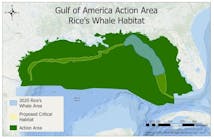GAO: Scant information exists about NEPA analyses’ costs, benefits
Little information exists about the costs and benefits of analyses required under the National Environmental Policy Act, the Government Accountability Office said. Federal agencies do not routinely track the costs, and there is no government-wide mechanism to do so, GAO investigators said they learned from officials at the US Environmental Protection Agency, White House Council on Environmental Quality, and other agencies.
“Information on the benefits of completing NEPA analyses is largely qualitative,” the Apr. 15 report continued. “According to studies and agency officials, some of the qualitative benefits of NEPA include its role in encouraging public participation and in discovering and addressing project design problems that could be more costly in the long run.”
The fact that federal agencies’ activities under NEPA are hard to separate from other required environmental analyses under federal laws such as the Endangered Species Act and the Clean Water Act; executive orders; agency guidance; and state and local laws further complicates analysis of NEPA’s costs and benefits, GAO said.
“This report substantiates concerns that the federal government has no system to track time or costs associated with NEPA, which is one of the most expansive regulatory laws in the country,” US Rep. Rob Bishop (R-Utah), who chairs the House Natural Resources Committee’s Public Lands and Environmental Subcommittee.
NEPA is important for many reasons, but delays and problems associated with its processes are significant, he maintained. “I am also very troubled by the constant use of NEPA as a litigious weapon to halt or delay projects that wealthy special interest groups don’t like,” said Bishop, who requested the investigation.
‘Costly, hidden, duplicative’
Officials of two associations representing US oil and gas producers also responded to the report’s findings. “The NEPA process has been found to be costly, largely hidden from the public, and duplicative of other environmental legislation,” said Daniel T. Naatz, Independent Petroleum Association of America’s vice-president of federal resources and political affairs.
“This report echoes the problems America’s independent producers have encountered when dealing with a variety of agencies regarding environmental assessments, environmental impact statements, and categorical exclusions,” Naatz said, adding, “Independent producers continue to struggle to operate on federal lands and NEPA continues to be an opaque barrier for entry.”
NEPA analysis was originally designed to enable transparent disclosure of environmental and economic impacts from federal projects so that impacts could be mitigated and better decisions made, according to the Denver-based Western Energy Alliance. The 1970 law was not designed to be a means for unaccountable environmental groups to raise money while stopping social progress, it added.
“GAO confirmed what western producers have been struggling with for years: long, drawn-out NEPA analysis that prevents economic growth and job creation,” said Kathleen Sgamma, WEA vice-president of government and public affairs. “NEPA delays to proposed western oil and gas projects on public lands are holding up nearly 79,000 jobs and $17.8 billion in annual economic activity.”
Contact Nick Snow at [email protected].

Nick Snow
NICK SNOW covered oil and gas in Washington for more than 30 years. He worked in several capacities for The Oil Daily and was founding editor of Petroleum Finance Week before joining OGJ as its Washington correspondent in September 2005 and becoming its full-time Washington editor in October 2007. He retired from OGJ in January 2020.
